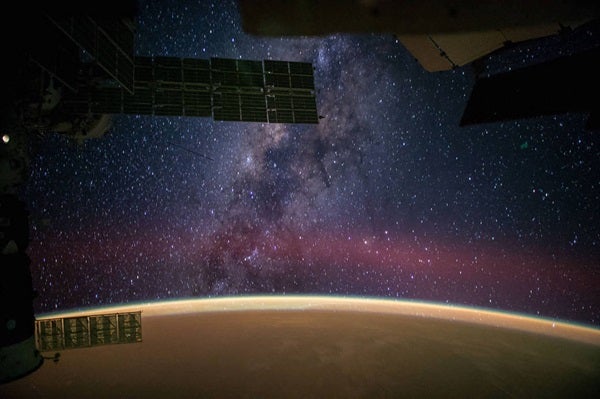This photo of the Milky Way, taken from the International Space Station in 2014, shows just a small fraction of the stars in our galaxy. A new study identified the compositions of more than 340,000 stars in an effort to match them with their long-lost galactic siblings.
The Sun is quite isolated now, but just like every other star, it was born in a stellar nursery along with thousands of siblings. Once very close knit, the Sun and its galactic brethren were eventually torn apart by the tidal force of the Milky Way, and are now scattered about the galaxy. They may have been torn apart by happenstance, but their shared origin means that the brothers and sisters are still bound by their chemical compositions. In an effort to match stars with their relatives, an international team of researchers collected the chemical profiles of over 340,000 stars in the Milky Way.
The Galactic Archaeology with HERMES (GALAH) survey used a specially designed spectrograph called HERMES to compile spectra of the 340,000 stars, with a goal of examining over a million stars before the survey’s completion. In addition to matching stars with their cluster of origin, the research team hopes to gain insight into the Milky Way’s history.
“No other survey has been able to measure as many elements for as many stars as GALAH,” said HEREMES instrument scientist, Dr. Gayandhi De Silva of Australian Astronomical Observatory (AAO), in a press release. “This data will enable such discoveries as the original star clusters of the Galaxy, including the Sun’s birth cluster and solar siblings — there is no other dataset like this ever collected anywhere else in the world.”
When starlight reaches a spectrograph, the light is separated into its different wavelengths, which helps astronomers determine the star’s chemical composition. HERMES, which is fitted on AAO’s 3.9-metre Anglo-Australian Telescope, used spectroscopy to record the abundance of almost two dozen different chemical elements in each star, including aluminum, iron, and oxygen. Since stars born in the same cluster share the same chemical profile, analysis of their makeup helps reveal galactic relations.
However, analyzing such a colossal amount of data is far too difficult to do by hand.
“We train [our computer code] The Cannon to recognize patterns in the spectra of a subset of stars that we have analyzed very carefully, and then use The Cannon’s machine learning algorithms to determine the amount of each element for all of the 340,000 stars,” said Sven Buder, a PhD student at the Max Planck Institute for Astronomy in Germany and lead author of the scientific paper describing the GALAH data release.
Although automation helped with the analysis process, surveying the stars was left solely up to the astronomers. To collect enough photons for a full spectral analysis, each star needs to be observed for roughly an hour, according to Dr. Jeffrey Simpson of the AAO. Luckily, their instruments allowed them to survey 360 stars at a time. Even at that rate, the researchers still clocked in over 280 nights of observation since 2014. In order to reach their goal of observing one million stars, they better be comfortable camping out around the telescope — or at least in the control room nearby.
This new data from the GALAH survey was published this week in Monthly Notices of the Royal Astronomical Society along with 10 other companion papers. This comes just days before the April 25 release of data from the European Gaia satellite, which has created the largest and most precise map of the Milky Way to date. It has recorded the distances to and locations of over 1.6 billion stars, and by incorporating stellar velocities collected by GALAH, Gaia is also capable of tracking their galactic motions.
By compiling the DNA signatures of so many stars in the Milky Way, astronomers will not only be able to track down the Sun’s ancestry, but also see how different star clusters migrated throughout the galaxy, giving us a better understanding of cosmic origins.










